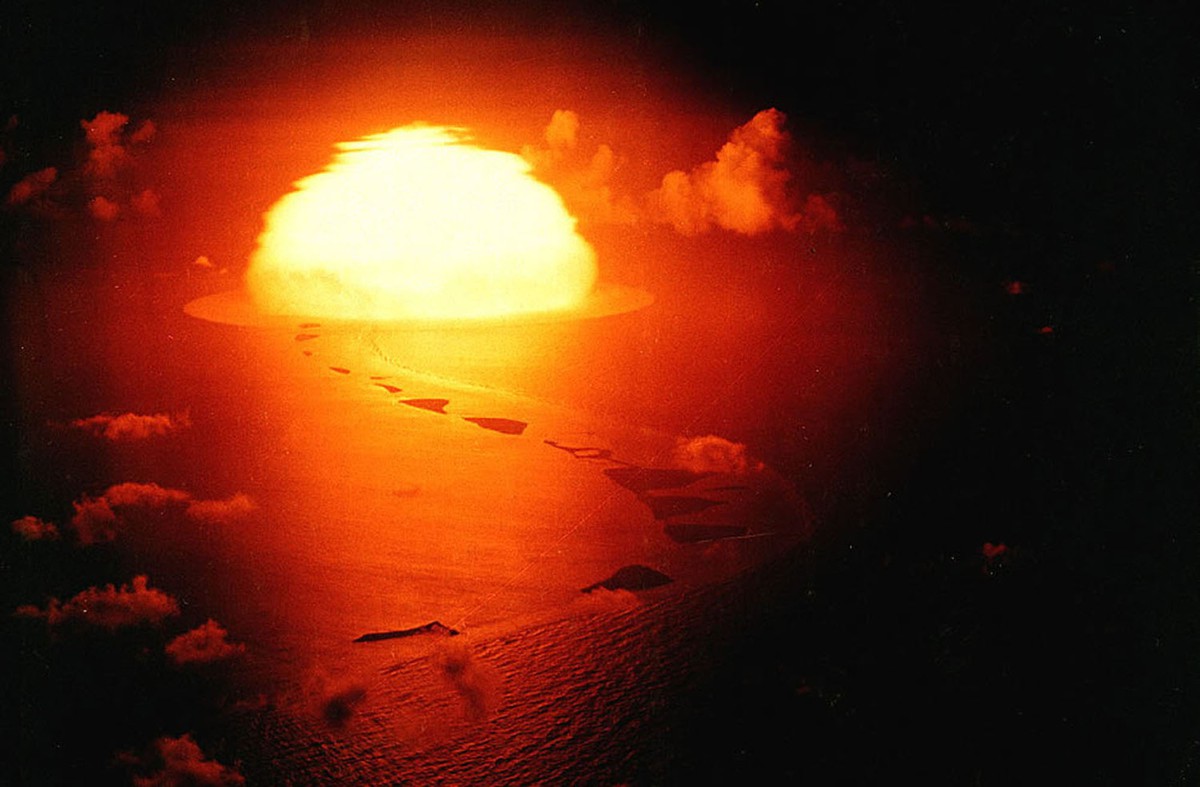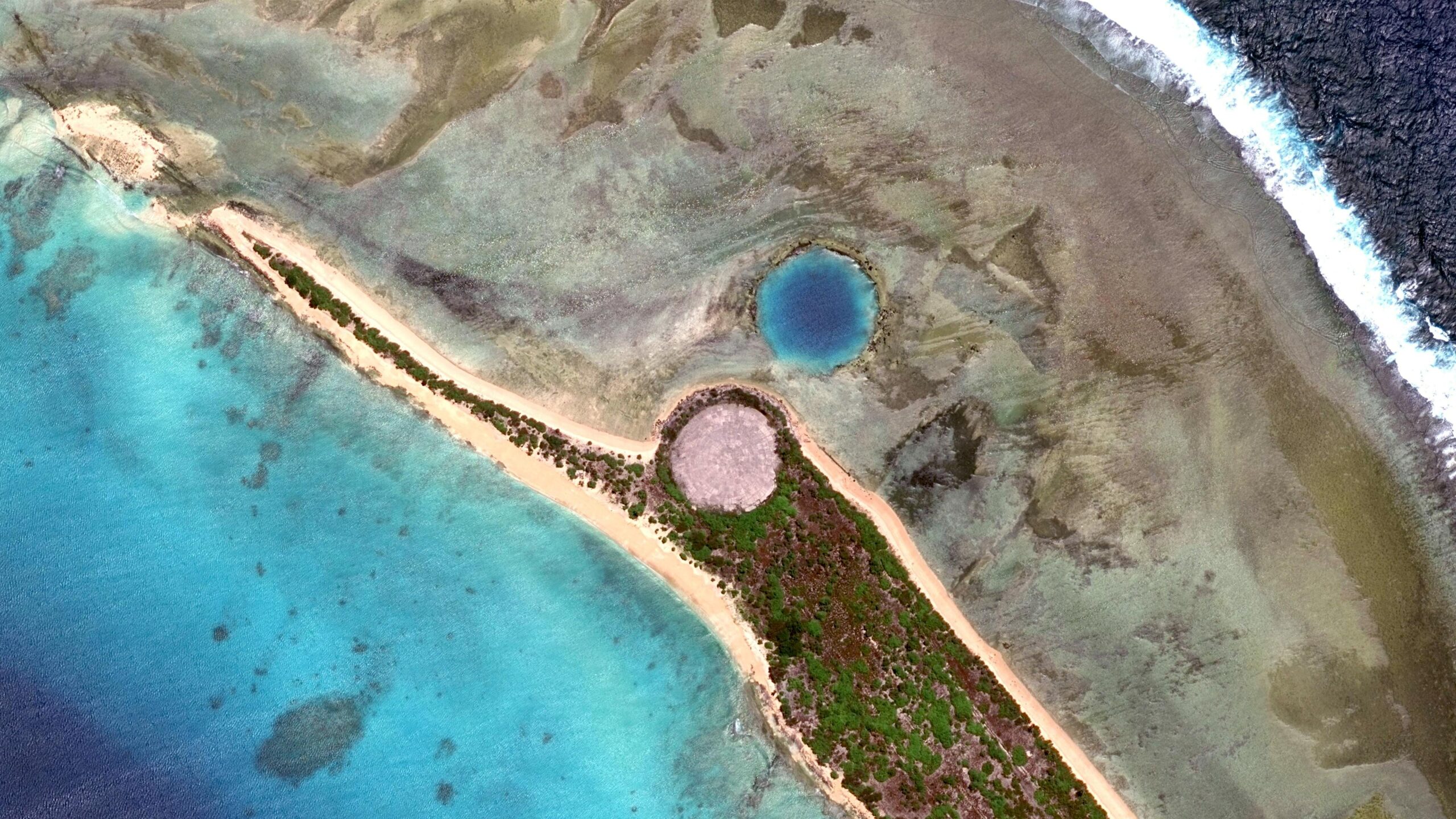In their introduction to the special issue on transnational nuclear imperialisms in the Journal of Transnational American Studies (2020), Anaïs Maurer and Rebecca Hogue compellingly argue that the nuclear industrial complex finds its roots in settler colonial logics — a structure they refer to as “nuclear imperialisms,” and which they define as
the state-sponsored, systemic mode of oppression in current or former sites of empire through any use of the nuclear complex . . . that involve[s] multiple empires, technologies, and ideological framings that exist and extend beyond geographic, temporal, and national boundaries and borders.
Maurer and Hogue 27
Atomic matters, indeed, cannot be reduced to a symbolic mushroom cloud — a symbol of the bygone Cold War era sometimes used as a plot device in Western speculative fiction. Nuclear imperialisms, instead, must be understood as a multi-scalar ongoing process which
rel[ies] on large-scale terra-deforming, excavating, biociding, mining, transporting, detonating, stock-piling, and waste disseminating and disposing associated with nuclear energies and weaponry.
Maurer and Hogue 34
Atomic matters, in other words, require to be thought not in isolation but as a circuit of actions, decisions, and discourses that are made possible by, and in turn extend, settler colonial situations. The American nuclear strike force was developed and tested on Indigenous lands (continental U.S. and Oceania). The uranium necessary to conduct these tests was mined predominantly on Diné (Navajo) and Dene lands. The scenario is similar for France and the U.K. which tested their weapons, respectively, in the deserts of Algeria and Australia as well as on “distant” islands in Oceania, often (ex) colonies of their empire.
To illustrate the temporal, spatial, and imperial core of their argument, Maurer and Hogue invite us to consider the life cycle of a uranium atom on its journey along the atomic circuit — a journey we should follow here too.
1. Prospecting and extracting

Tamgak open air quarry at the Orano Arlit mine site in Niger. Credits: Reuters.
Before being used as fuel for power plants, that is, transformed into energy, uranium must be prospected and then extracted. Today still, the vast majority of uranium ore that is sold on the global market is mined on Indigenous land in Australia, Canada, Kazakhstan, the continental United States, and Niger, to name only a few places. And while extractive processes always displace people and destroy the environment, uranium mines, especially once closed, pose additional health hazards due to their radioactivity, poisoning the communities living in the vicinity of mining sites. Uranium extraction, then, does not only involve settler colonial occupation and displacement (in the case of the U.S., Canada, and Australia which are settler nation states, this is all the while more obvious); its entanglement with imperialism also manifests through the lingering radioactivity this type of extraction leaves in its wake.
2. Transportation

A uranium mill tailings to the Crescent Junction disposal cell. Credits: Energy.gov
Once extracted, uranium must be shipped to various locations to be transformed, enriched, or purified — a necessary alchemical process if it is to be used by the nuclear industry. As such, uranium-filled containers will travel thousands of kilometers on trucks, trains, airplanes, and/or ships, often across Indigenous territories. For example, and as Maurer and Hogue remind us, uranium mined in Australia and shipped to the United States will cross the borders of Pacific nations that have time and again “opposed the presence of radioactive material within their national borders” (30).
3. Nuclear power plants

Cattenom nuclear plant in the Moselle region, France. Credits: Arnaud Bouissou/MEDDE/IRSN.
Once adequately transformed, uranium can serve many purposes, though it is most commonly used by nuclear power plants for the production of electricity. While power plants do pose potential and catastrophic risks, as Fukushima and Chernobyl in particular have testified, the increase in technology have considerable decreased the probability of an accident. Nevertheless, living near a nuclear power plants increases the health risks associated with radioactivity. The waste at the end of the power production cycle, which is often stored on site, is an additional and serious hazard due to its high radioactivity. The discrepancy in terms of health mitigation at different ends of the atomic circuit, as Maurer and Hogue note, is racially coded: “National priority was clearly given to securing nuclear plants located near populated (predominantly white) areas, rather than to ensuring the safety of nuclear storage facilities mostly located near Indigenous communities” (31).
4. Atomic bombs

Operation Greenhouse, test “George.” Credits: Michael Light.
Since “Trinity,” the first atomic bomb detonated in Alamogordo, New Mexico, in July 1945, there have been 2,056 devices tested by a total of eight nations: the U.S., the U.S.S.R., the U.K., France, China, India, Pakistan, and North Korea. Half of these tests were conducted by the United States alone (1,032) while the U.S.S.R. accounts for approximately 34% (715) and France 10% (210). 25% of the total of bombs exploded in the atmosphere, dispersing their radioactive materials around the globe.
The necropolitcal use of atomic energy is never too far from that of the supposed “peaceful” one. As Maurer and Hogue note, generating electricity remained, for many decades, “a secondary purpose for existing reactors whose main function was to produce fuel for weapons, and electricity profits were used to fund the weapons program” (31). Indeed, plutonium-239 (239Pu), a byproduct of nuclear fission, is a highly radioactive and dangerous isotope which was subsequently used in the creation of atomic bombs. The weapons were then tested at locations “systematically situated far from the nuclear countries’ economic and political centers, in lands occupied by differently racialized, disenfranchised, and impoverished people” (Maurer and Hogue 31), most notably in desert and oceanic regions where the populations continue to suffer from radio-induced diseases.
5. Waste repositories

Satellite view of the Runit Dome, a large nuclear waste repository in the Marshall Islands, next to the “Cactus test” crater. Credits: Google Earth.
Although it is often presented as a miraculously clean source of energy in the global “fight” against climate change, as the recent decision by the European parliament testifies, our journey through the atomic circuit should have made clear that nuclear energy is anything but “green.” Indeed, while nuclear power plants have particularly low carbon emissions for a large amount of energy produced, the risk they pose and the waste they generate is highly radioactive on incredibly long periods of time (up to thousands of years). Like most of the different stops on the circuit, high activity nuclear waste tends to be stored in places removed from densely populated areas, most often on Indigenous lands, in conditions that can, at times, cause leaks. The Runit dome in the Marshall Islands is perhaps the most compelling example: this “tomb” sealed with concrete, quickly assembled to burry the waste of many of the American atomic bombs on Enewetak Atoll, is now becoming an urgent situation. As global warming continues to impact the environment, leading sea levels to rise and coral to erode, the already crumbling Runit dome threatens to break and leak its highly radioactive materials into the ocean. This calls for our attention to a fundamental reality of nuclear waste, as Peter C. van Wyck writes in Signs of Danger (2004): nuclear materials defy our assumptions about waste, for they can “neither be completely accumulated (contained), nor spent (disposed).” Nuclear materials, in fact, “[tend] to drift” (4).
Works cited
Maurer, Anaïs, and Hogue, Rebecca. “Special ForumIntroduction: Transnational Nuclear Imperialisms.” Journal of Transnational American Studies, vol. 11, no. 2 (2020): pp. 25-43.
Van Wyck, Peter C. Signs of Danger. University of Minnesota Press, 2004.